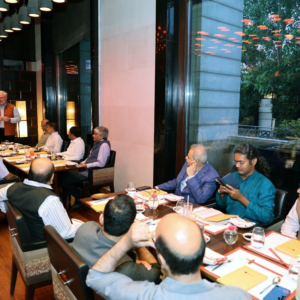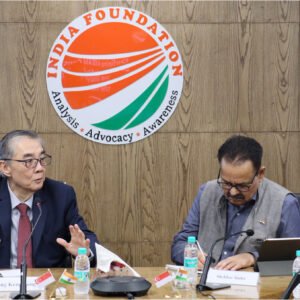The recent rapid growth of the economy has positioned India more seriously than ever as a major power in world politics, and it is often paired with China as part of the vibrant rise of Asia. But how should India understand and invest in its growing power?
Traditionally, power in world politics was seen in terms of military power. The side with the larger army was likely to win. But even in the past, such a view underestimated the non-tangible aspects of power. And that is more important than ever in the information age. While military power remains important, it does not produce power on the Internet or in dealing with climate change or financial instability. Judging power is more complex than it first appears.
Simply put, power is the ability to alter the behavior of others to get what you want, and there are basically three ways to do that: coercion (sticks), payments (carrots) and attraction (soft power). If you are able to attract others, you can economize on the sticks and carrots. Of course, drinking coke or watching a Bollywood film does not automatically convey power for the United States or India. Whether the possession of soft power resources actually produces favorable outcomes depends upon the context. This is not unique to soft power. It is true of hard power as well. Having a larger tank army may produce military victory if a battle is fought in the desert, but not if it is fought in a swamp.
The soft power of a country rests primarily on three resources: its culture (in places where it is attractive to others), its political values (when it lives up to them at home and abroad), and its foreign policies (when they are seen as legitimate and having moral authority). Soft power depends upon attraction, and this can vary among countries, groups and generations. For example, America’s culture produces soft power among some young people, but not others. Similarly, Indian films produce attraction among some viewers more than others.
Economic resources can produce both hard and soft power behavior. A vibrant economy like that of China or India produces a capacity for hard coercion or payments, but a successful economy is also an important source of soft attraction. Sometimes in today’s world, it is difficult to distinguish what part of an economic relationship is comprised of hard and soft power. For example, China’s “Belt and Road Initiative” (BRI) produces both, but the harsher the terms of loans, employment and control in a country, the less soft power the BRI produces in that country.
Because soft power has appeared as an alternative to raw power politics, it is often embraced by ethically-minded scholars and policymakers. But like any form of power, it can be wielded for good or bad purposes. Hitler, Stalin, Mao and bin Laden all possessed a great deal of soft power in the eyes of their acolytes, but that did not make it good. It is not necessarily better to twist minds than to twist arms. We often judge ethics on the three dimensions of motives, means and consequences. Fortunately, while soft power can be used with bad intentions and wreak horrible consequences, it does differ in terms of means because it depends upon the attraction of the subject. Contrast the consequences of Gandhi’s choice of soft power with Yasser Arafat’s choice of the gun. Gandhi was able to attract moderate majorities in Britain to favor India’s independence, and the consequences were impressive both in effectiveness and in ethical terms. He left an important legacy for India’s soft power. In contrast, Arafat’s strategy of hard power, particularly in the second intifada, undercut Israeli moderates and drove politics into the arms of the hard right. The unfortunate consequences persist to this day.
Military force remains crucial in world politics for deterrence and defense. But military resources can also contribute to soft power. A well run military can be a source of attraction, and military to military cooperation and training programs, for example, can establish transnational networks that enhance a country’s soft power. The skills and professionalism of its military is an important source of both hard and soft power for India. The impressive cooperation of the Indian and American militaries in providing humanitarian relief after the Indian Ocean tsunami in 2004 enhanced the soft power of both countries. Such exercises continue.
On the other hand, misuse of military resources can undercut soft power. The Soviet Union’s resistance to Hitler produced a great deal of soft power for it in the years after World War II, but the Soviets destroyed it by the brutal way it used its hard power against Hungary and Czechoslovakia in 1956 and 1968. The US similarly damaged its soft power by wars in Vietnam and Iraq. Brutality and indifference to just war principles of discrimination and proportionality can destroy legitimacy. The efficiency of the initial American military invasion of Iraq in 2003 created admiration in the eyes of some foreigners, but that soft power was undercut by the subsequent inefficiency of the occupation and the scenes of mistreatment of prisoners at Abu Ghraib. How India responds to jihadist terrorism will affect India’s soft power.
There is very little likelihood that the United States, India or other democracies can attract jihadist terrorists. India suffered terribly in the Mumbai attacks. We need hard power to deal with such hard cases. But the current terrorist threat is not Samuel Huntington’s clash of civilizations. It is a civil war within Islam between a mainstream majority and a small minority such as the Islamic State who want to coerce others into their simplified and ideologized version of Islam. Neither India nor the United States can win this struggle unless the mainstream Muslims win. That is impossible without soft power, and we cannot win hearts and minds without it. Soft power is more relevant than ever.
Looking ahead, China and India are the looming giants of Asia, with their huge populations and rapid economic growth rates. Not only are their hard power resources growing, but both countries have attractive traditional cultures. In 2007, President Hu Jintao told the 17th Congress of the Chinese Communist Party that it needed to invest in soft power and President Xi Jinping has continued that line. China has invested in Confucius institutes to promote Chinese culture, and it is promoting its film industry, but Bollywood produces more movies every year than China – or Hollywood for that matter. Indian writers reach large audiences overseas. Large expatriate communities in the United States have increased interest in their home countries in America as well as in Europe. Moreover, the transnational connections in the information industry are close, as high-tech companies increasingly employ affiliates in Bangalore and Silicon Valley.
The real soft power promise for China and India still lies in the future. A country’s soft power rests upon the attractiveness of its culture, the attraction of its domestic political and social values, and the style and substance of its foreign policies. In recent years, both China and India have adopted foreign policies that have increased their attraction to others. But as the Soft Power 30 Index produced by the London consultancy Portland shows that neither country yet ranks as high on the various indices of potential soft power resources as the U.S., Europe and Japan. Polls show that this remains true despite the damage that President Trump’s policies have done to American soft power. Fortunately, much of the soft power is produced by civil society, not government. That helps to explain how American soft power recovered after Vietnam, and will probably do so again after the Trump years. While culture provides some soft power, domestic policies and values set limits, particularly in China, where the Communist Party fears allowing too much intellectual freedom, censors the internet, and resists outside influences.
This is where India possesses an advantage. China has grown more rapidly and done more to reduce poverty over the past two decades, and should be applauded for that, but China has not yet come to terms with the problem of increased political participation and recent events seem to be going in the wrong direction. India was fortunate to be born with a democratic constitution and political structure. This means that it has already passed a test that China still faces in the future, and that makes India a source of attraction to other countries. Of course, India still faces daunting challenges of poverty, unequal treatment of women, inequality tied to a caste system, and corruption and inefficiency in the provision of public services. But India is also changing and adapting within a broad democratic framework, and many foreigners find that attractive. Despite its many problems, it is a safe bet that India’s hard and soft power are both likely to increase in the coming decades. If India can combine the two successfully, it will be a “smart power.”
Fortunately, soft power does not have to be zero sum. If we wish to avoid conflict, we can all benefit if the attraction of another country rises in our own country. Similarly, given the rise of new transnational challenges like climate change, financial stability, pandemics, and terrorism which no one country can solve by itself, increases in soft power can pave the way for the cooperation the world will need to meet such problems. Fortunately, soft power can be part of a vision which understands the importance of power with others rather than merely over others. India can help lead the way.
(Prof. Joseph S. Nye, Jr. is a professor emeritus at Harvard University, a former assistant secretary of
defense, and author of ‘Soft Power: The Means to Success in World Politics’.)
(This article is carried in the print edition of March-April 2019 issue of India Foundation Journal.)



